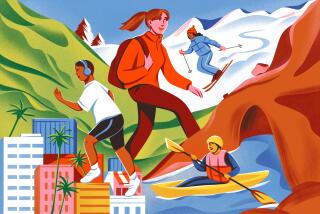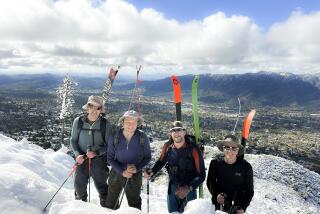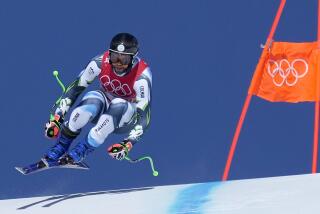THE TURKEYCLIMB : It’s Five Minutes of Agony If You’re Any Good; If You Aren’t, the Pain Lasts Longer
- Share via
Mountaingate Drive, which ought to be nicknamed Mountaingate Dive, doesn’t look like a sensible site for a bicycle race.
The road leading from Sepulveda Boulevard to an exclusive housing project atop the Brentwood hills is among the steepest public streets in Los Angeles.
The view from the peak is great, but the same might have been said of the 90-meter ski jump hill at the 1960 Olympics in Squaw Valley.
If you had to ride a bicycle on Mountaingate Drive, up would not be the obvious direction of choice. But that is how 311 cyclists attacked the hill Sunday in the eighth annual Turkey Climb.
The paved cliff they scaled looks better suited to a mountain-climbing championship, where competitors could subdue its angles with the aid of ropes and grappling hooks.
Given the advantage of a vehicle, residents clearly favor a diesel Mercedes over a Schwinn, and first gear is the proper approach, regardless.
But in the cycling world, Mountaingate Drive seems to inspire the same sense of challenge that led George Leigh Mallory to climb Mt. Everest--”because it is there.”
Ten years ago, before the construction of the fancy hilltop homes, the road led to a county garbage dump, and served a different purpose for cyclists.
Back then, the hardcore types liked to hurtle down the hill at speeds of 50 m.p.h. behind the garbage trucks--a pursuit called slip-streaming because the cyclist is pulled along in a pocket of air created by the bigger vehicle.
Sunday’s race was strictly the opposite challenge.
It got its name from hill-climbs popular early in the century, when the winning cyclist was awarded a live turkey. The director of this race, Joe Kossack, tried to maintain tradition by offering packaged turkey parts as prizes one year, but they thawed in his trunk during the race.
“My car never smelled the same,” Kossack said.
Without that incentive--but with a prize list totaling $3,000--Sunday’s event drew such cycling celebrities as three-time Olympian John Howard and Michael Secrest, who placed second in the Race Across America this year.
Howard recently earned the title of “the world’s fastest man on a bicycle,” after riding 152 m.p.h. in the slipstream of a race car on the Bonneville Salt Flats in Utah.
One no-show was last year’s winner, Olympic gold medalist Steve Hegg, who “could not come to terms with race promoters to defend his title,” according to Race Director Joe Kossack.
The competitors’ goal was to test their guts against Mountaingate Drive’s 20% grade--probably the worst grade some of the cyclists had faced since their trigonometry days.
“Make sure that breakfast is firmly lodged in your stomach,” the race announcer cautioned entrants. “We wouldn’t want anybody to lose it.”
Indeed, a few riders did conquer the hill at their innards’ expense. But they were viewed with tolerance and even a strange sort of pride by their peers.
“That’s an accepted thing in cycling,” said rider David Reese. “It’s a sign you gave 100%.”
To scale the mile-long course with its 1,000-foot increase in elevation certainly demanded close to total physical and psychological effort.
Organized as a time trial, one rider was launched from the bottom of the hill every 30 seconds. Unlike most bicycle races, which are pack events, the misery of the Turkey Climb is not relieved by company.
“It’s a matter of how long you can hold your hand in the fire,” said Michael Levy, who had ridden the race in previous years, but joined the event’s staff this year due to a cold.
“You’re in total oxygen debt,” he said. “It’s almost as bad as trying to swim 200 yards under water.”
Several hundred spectators lined the course to watch competitors pump, wobble or creep their way to the top.
The scene at the finish line was intense.
Since most serious riders lock their feet onto their pedals for added power, a support team was obliged to run alongside most finishers, holding the bike upright while somebody freed the exhausted rider’s feet.
One woman racer cleared the finish line glued into hill-climb posture.
Even when the staff caught hold of her bike, her eyes remained riveted on the horizon, her fingers seemingly frozen to her handlebars. After a moment, she unwrapped them, one-by-one.
“The best finishers are semi-conscious,” said one recovered participant, standing next to the first-aid car dispensing oxygen out of a tank in the back seat.
Working on the support staff required vigilance. Many finishers quit pedaling, and ran a risk of rolling back down the hill if they weren’t grabbed in time.
Rider No. 160, Mike Boerem, under the encouragement of the crowd at the finish, pushed himself to the limit. A yard clear of the finish line, he began to topple, bike and all, like a redwood tree.
Supporters surrounded him and the rider summoned the breath to gasp out five words: “Do you have my time?”
He then collapsed on the curb and looked down.
“My legs are blue!” he remarked with little surprise. It was true; they almost matched the frame of his bike. Boerem finished fourth in his class, U.S. Cycling Federation category III, with a time of 5:37.49.
Rider Mark Cooper, a Costa Mesa engineer, was not quite as quick. “That was the most agonizing seven minutes of my life. Sometimes you just wanted to stop, but the crowd keeps you going for fear of embarrassment.”
The race was won by Shane Luncinski of Canoga Park in 4:36.88. In Sunday’s headwind, his time was well off the 4:14 course record held by Torrance’s Tomas Rodriguez, who did not compete this year. Howard was 11th and Secrest was 14th.
But in the women’s division, 19-year-old Ruth Matthes of Laguna Beach, a former ski racer, managed to break the course record. Matthes’ winning time of 5:46 beat Jennifer Kraft’s mark by one second.
Kraft, a 21-year-old Van Nuys resident and a senior at UCLA, said she has not been able to devote as much time to training this year. She was second in 5:58. Despite the 30-second starting intervals, she and Matthes each passed three men toiling up the hill.
Not everybody turned out with the dream of winning it all. A number of the participants entered on Stumpjumper mountain bikes or home-made constructions.
A few were “funny bike people,” or members of the Human Powered Vehicle Assn, like 58-year-old Ramondo Spinnetti.
Unlike other cyclists, who had stripped off as much as 45 pounds of equipment to reduce their bikes to hill-climbing weight, Spinnetti rode something long, low and green.
It wasn’t necessarily light since he had built it himself by turning a ladies bicycle frame upside down and attaching small wheels on the bottom.
The bike, designed to be pedaled in a backward motion, sported such extra equipment as a horn, mirror, and backpack, from which Spinnetti produced press releases entitled “Contradirectional Drive” on request.
The more conventional cyclists couldn’t resist a little fun at his expense.
“Here’s the man on the laid back machine,” the announcer said at Spinnetti’s start. “He’s got a map, so he must be planning to spend the day on the hill.”
Another out-of-the-ordinary means of transportation was used by George Garcia of Colombia. The world champion roller skater in the 100-kilometer event spurned a bicycle and tackled the killer hill on a $400 pair of skates, which is even harder. He said his 7:48 time was a Turkey Climb skating record.
A team of Colombian cyclists also entered the Turkey Climb and found themselves right at home on the hill.
“That’s all we have in Colombia,” said Garcia, a resident of Bogota. “It’s either uphill or downhill. Everywhere you go, hills, that’s it.”
Jonathon Seutter of Beverly Hills, who says he holds the record for roller skating from Los Angeles to San Diego, said he would rather have skated up the hill, but was forced by a shoulder injury to ride his bike, instead.
His bike drew a few comments of its own. In place of the brand name, it read “3 Stooges” and the immortal words “Nyuk, Nyuk” were painted on the seat stays.
“Roller skaters tend to crack a lot of jokes,” said Seutter, who races in both sports. “They tend to be less serious (than cyclists). When I’m in the crowd in a bike race, I like to yuk it up, give a few Three Stooges noises. I’ve had guys tell me flat out to shut up.”
Seutter ran into a couple problems with his bike on the Turkey Climb. He lost a toe clip and then slipped out of gear and was “thrown right off the bike.”
Although he persevered on to finish the race, he later conceded: “I wasn’t cracking any jokes today.”
More to Read
Go beyond the scoreboard
Get the latest on L.A.'s teams in the daily Sports Report newsletter.
You may occasionally receive promotional content from the Los Angeles Times.







